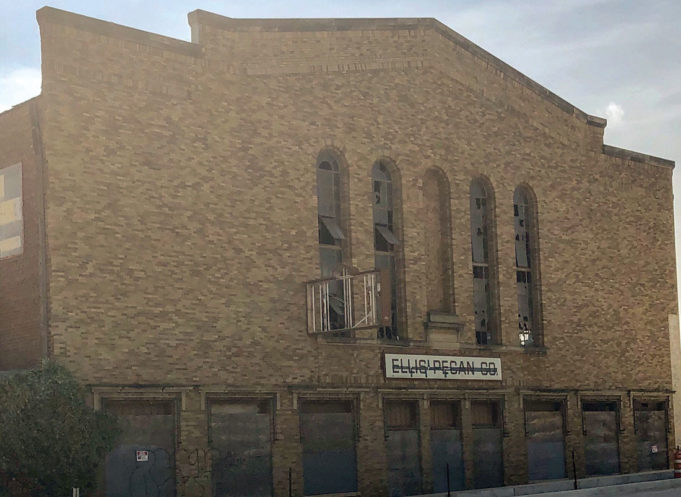The best thing to ever happen at 1012 N. Main St. was when the former Ku Klux Klan hall, built in 1920, was firebombed. No one was killed, but the decision in 1925 to rebuild KKK Klavern 101 – the long-abandoned brick, steel, and glass brick box just north of downtown – has allowed civic leaders to sugarcoat a long overdue dialogue about race relations.
The haven for the legion of local white hoods with a prime view of the county courthouse was a 4,000-seat two-story theater where magician Harry Houdini performed, among others. Fronting North Main is a tall, buffed yellow-brick facade, with a sharp sloping roof. Three cast iron-trimmed doors and six windows sit below a decorative brick arch and four arched glass windows.
Even with a new grand hall, their reign of terror did not last long. Despite including some of the city’s business and civic elite, the group’s membership dwindled. The hall closed and had a rich, brief history as a boxing ring, an auditorium, and a warehouse for the famous Leonard’s department store.
The only visible remnant of its last occupant, the Ellis Pecan Company, is a flat, wooden red-and-white sign attached above the boarded-up entryway. A small hollowed-out vinyl sign sits above the sidewalk. Yet the entrance is blocked by construction for a Trinity River bypass channel.
Last month, owners Sugarplum Holdings filed a permit to remove its demolition-delay status. DD status is the lowest on the totem pole of preservation, last stop before permitting an owner to tear down a structure of historical significance. A city report estimates between $8-$10 million in repairs, citing the owner’s lack of effort to secure historic designations and funds to rehab it in the first place.
Yet on July 8, the city’s Historic and Landmarks Commission voted 5-1 to delay demolition for another 180 days to explore alternatives. Among the alternatives is working with DNAWorks, a New York-based nonprofit cofounded by TCU Assistant Professor of Dance Adam McKinney, who has pitched a plan to make it into a center for arts and healing. The idea would be to reclaim the site from its white supremacist past.
The most visible signs of any warehouse are the loading docks added by Leonard’s. They extend next to alternating tall-arched multipane windows and buttress piers on the north and south ends, similar to the former Fort Worth Recreation Building at 215 W. Vickery Blvd. Built in 1927, the slightly younger of the two is regularly confused for the hall, even in the shoddy engineering report commissioned by Sugarplum. The differences are also clear. The older sibling is worn.
Preservationists and conservative activists have formed an unorthodox alliance, questioning the motives and reasons for tearing down the hall. Conservative activists came to its defense faster than you can say, “Tear down that wall!” (Or, more appropriately, in modern conservative parlance, “Build the wall!”) The less architecturally inclined see it as a threat not to architecture or preservation but as an ongoing campaign by left-wing activists to tear down and remove historic Confederate monuments.
The comparisons are not the same, according to one advocate for preservation. “The understanding of the violent, white supremacist Klan placing a very large building in direct view of the county courthouse, not just once but twice, should prevent us from comparing its proposed restoration to the preservation of the cabins of enslaved people or Lost Cause Confederate memorials,” said Kathryn Holliday, the director of UTA’s David Dillon Center for Texas Architecture.
The history is important to the aesthetes, too, but the architecture enthusiasts still see potential in one of city’s the last few structures of massive density from the 20th-century styles in the city. It may need a new roof and windows, they say, and preservationist group Historic Fort Worth has enough hope to include it as part of a rotating collection of structures on their annual most endangered list.
Both camps ask a fair question: Should all buildings with past egregious associations be demolished? But the question is like another shiny ball, distracting and taking away from the real question: When will the city reckon with the destruction and neglect of black historical spaces?
Historic Fort Worth’s annual preservation list includes some of the last remaining historically black sites in the city, and significant sites for Texas black history, including the cross-shaped, yellow-brick Wayside Church of God in Christ, the last building standing in the former Trezevant Hill neighborhood. The Grand High Court of Heroines of Jericho headquarters, a 1952 brick house shaped like the White House, complete with an oval office, was added in 2017 to the endangered list. Meanwhile, in Mosier Valley, named for one of the first colonies for freed slaves in the state, a city park is far behind schedule. Some historic structures serve a significant purpose. The Ellis Pecan Building does, too. Demolition would not erase the vestiges of the Klan’s influence. Investment in historically black neighborhoods says volumes more about the city’s treatment of its past than preserving a structure that shouldn’t be but is tattered.
Preservationists should not have to choose between saving one and advocating for others. If negotiations fail, the blame isn’t for lack of trying, but it will be Fort Worth’s fault for putting them here in the first place.













What an absurd politically charged article.. The author has no concept of architectural preservation or sustainable building practices, but seems to want to point their “PC” finger at preservationists and conservatives for some social justice points.
The impacts on the environment to tear down a structure of this magnitude, only to rebuild in it’s place is extraordinarily wasteful and it’s horrible for the environment. Erasing the building doesn’t erase the history. Repurpose the building and create a bigger impact than what its prior abhorrent purpose served.
We arent going to tear down historical cathedrals because of the atrocities that the catholic church has been hiding for decades… But when they run out of followers and sell the church, we can repurpose them as a great number have in Europe. We aren’t tearing down historical court houses, even though they have issued racist, Jim Crow, discriminatory, segregative judgments (even the one in sight of this very same building). You can’t erase history by swinging a wrecking ball into a building.
Preserve the structure, respect sustainable environmental building practices, and find a more impactful purpose for the building than trying to erase it.
I assure you this writer knows a significant amount about architecture.
This is a RAG
James Russell is right. If the city or those with power want to save this old building it must save many of the historically black sites in this city that are facing the wrecking ball. If The Ellis Pecan building is saved than the names of KKK members who attended those meetings should be named and faces revealed.
“and a warehouse for the famous Leonard’s department store.”
___________________________
The famous Leonard’s department store was owned and operated by Marvin & Obie Leonard.
Marvin Leonard, sometimes called The Texas Merchant, was a klansman himself. Mr. Marvin was a member of Klavern 101. Klansman Marvin Leonard bought this Fort Worth KKK building. Klansman Leonard voted 19 times in klavern elections to sell the building to him. 19 signed ballots were found in Marvin Leonard’s wallet which included his KKK membership cards.
Tarrant Regional Water District director Marty Leonard is Klansman Marvin Leonard’s daughter.
KKK member Marvin Leonard founded Fort Worth’s Colonial Country Club and Shady Oaks CC.
______________________
Texas Merchant: Marvin Leonard and Fort Worth
By Victoria Buenger, Walter L. Buenger
Obviously, she is racist too. They can’t help it. It was ingrained in her from the beginning. I’m QUITE SURE, she knows her father was a slimy, disgusting, Klansman.
My grandfather and then my father ran the Ellis pecan plant. My sisters and I learned to walk in that building and I spent a lot of time there as a boy that wanted to go to work with is dad. To me the history is that of where I spent time as a young boy. I never knew the building history until I was an adult. In fact I remember one of the guys that worked there. His name was Milton, an African American gentleman that always was so nice to me. I remember he talked so loud and my dad told me it was from being around all the loud equipment. I also remember that he smiled all the time, remember I was young so I didn’t remember everything. I’m only writing about Milton because I really don’t think he had an issue with the building. If he did would he have worked there? I couldn’t say, I was too young. Every time I read about all the controversy about the building I remember Milton.
I still have the antique scale that was in the lobby, as well as a brass fire extinguisher that my grandfather used to put out a small fire he set upstairs.
Can I at least get a brick from the demolition? This building has history for many reasons, not just the original reason.